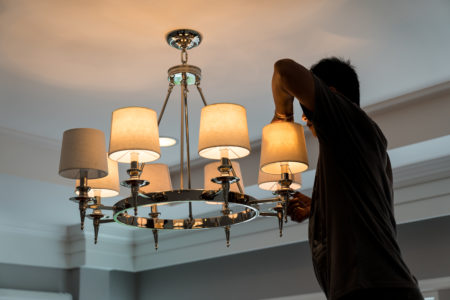
What Causes Lights to Flicker?
Lights in your home can dim and flicker for various reasons, some more harmless than others. Knowing when to call an electrician for your dimming or blinking lights is crucial to preventing shocks, electrocution, and fires. If you are wondering what causes lights to flicker, several minor problems and complications include:
- A problem with your lightbulb (like it is incompatible with your dimmer or the bulb is loose)
- A faulty light switch or fixture switch
- A loose connection between the light plug and outlet
- Appliances that need substantial current upon startup
A quick inspection of your home’s lights can often reveal if any of these issues are occurring. However, they are not typical and are often a more severe problem. These five primary causes of flickering lights include:
- Overloaded Circuit – If you notice flickering or blinking lights when you turn on a large appliance, it could be from an overloaded circuit. This problem usually is not too serious unless it happens all the time or lasts for more than a few seconds. Call a professional electrician to safely inspect your circuit if this occurs.
- Utility Service Issue – Utility service issues mainly occur for residents in a neighborhood because your house likely shares a transformer with the surrounding homes. If your block uses a lot of electricity, your lights might flicker. Calling a qualified electrician can determine the root of the problem and decide if it’s time to notify the utility company.
- Voltage Fluctuating – Most homes are on a standard 120–volt circuit, so your home should read between 115 and 125 volts. You can check this with a voltmeter. If it is higher than 125 volts, it could be causing your lights to flicker. Other ways to determine high voltage or fluctuations problems are frequent bulb burnouts, appliance or electronic malfunctions, and dimming lights at random and inconsistent times. Excess voltage is a safety hazard and should be dealt with immediately by a professional.
- Old or Loose Wiring and Connections – If you are experiencing flickering lights in the house, it could be from old or loose wiring. Old wiring or a loose connection might not seem like a big deal, but it is incredibly dangerous. According to The National Fire Protection Association, over 65% of home fires are traced back to a wiring issue. Old wiring could have been improperly installed or corroded over time. Loose connections in a light outlet or switch box can cause another safety hazard, called arcing. Arcing is when an electrical current “jumps” over a bad connection to keep flowing. Arcs can exceed 10,000 degrees and spark, causing an electrical fire. If you suspect this is the case, contact an electrician immediately.
- Main Connection Problems – Lights flickering in several areas of your home is often caused by an issue with the main connection or service cable connection. This is another instance where it is best to work with a qualified electrician to check your main meter box connection.
When in Doubt, Call the Professionals at Raynor Services!
Whatever the cause of your flickering lights, you can trust the professionals at Raynor to complete your lighting repair. Our team of electricians is experienced in several areas of indoor lighting, and we will take care of all your needs, no matter how large or small the job may be! Contact us today at 609-454-6655 to schedule a service.












